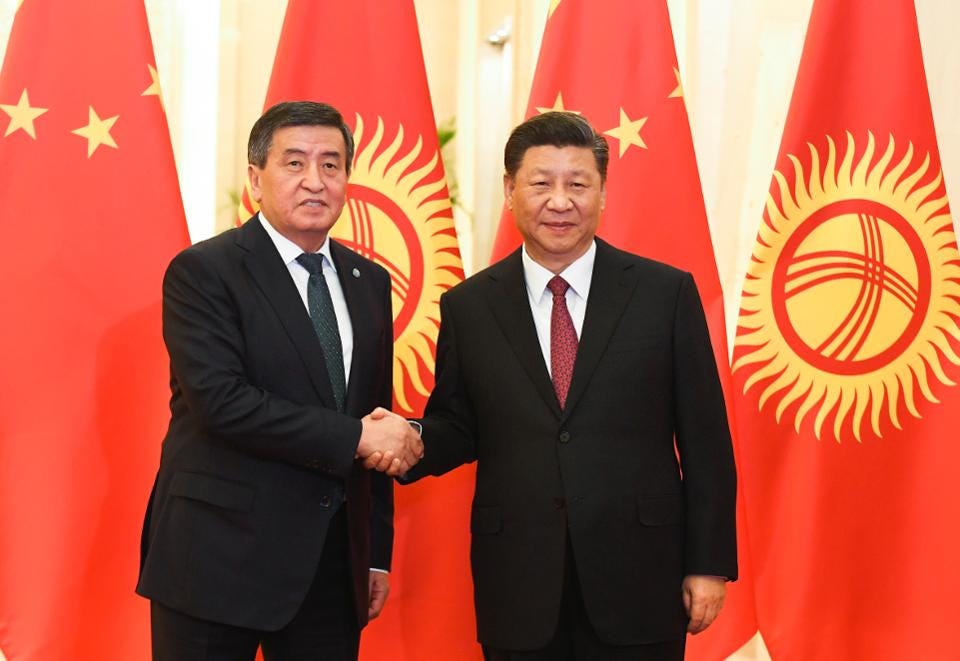Another Belt And Road Project Bites The Dust As China’s New Silk Road Continues To Struggle
China's BRI can't catch a break.

MADOKA IKEGAMI-POOL/GETTY IMAGES
Last year, during Chinese President Xi Jinping’s visit to Kyrgyzstan for a Shanghai Cooperation Organization summit, a new $275 million free-trade zone on the Kyrgyz-Chinese border was born. Led by the Chinese firm One Lead One (HK) Trading Limited and a Kyrgyzstan partner, the project was to become a vital artery of cross-border trade in Naryn region—à la Khorgos in Kazakhstan, a place where goods could flow freely between nations and people-to-people exchanges between cultures could blossom.
This was to be a joint venture between China and Kyrgyzstan that would see 200 hectares of land leased to the Chinese firm for 49 years that would include a giant logistics zone, a warehousing area, hotels and shopping malls, gifting modern development to yet another remote stretch of Central Asia. But these dreams were cut short by a stark reality: The Kyrgyz people said no.
This free-trade zone was not interpreted locally as a mutually beneficial win-win trans-national partnership that would advance China’s Belt and Road while boosting the local economy and creating new opportunities for the local Kyrgyz people, but as more as a land grab. Depending on the report, anywhere between 800 and 2,000 people took to the streets in the village of At-Bashi on February 17 and demanded that the project not be allowed to continue while holding signs like “We Are Against The Logistics Center.”
Without much of a fight, the Chinese side relented and pulled out of the project, leaving the remains of yet another incomplete project strewn along what was supposed to have become a new Silk Road.
This Kyrgyz free-trade zone joins a long list of other failed, downsized or readjusted Belt and Road projects that stretch across Asia and Africa. Melaka Gateway is currently a barren slab of reclaimed land lingering off the coast of Malaysia, polluting the local ecosystem and disrupting the livelihoods of a one-of-a-kind Portuguese community who speak a UNESCO-protected language. Hambantota was supposed to rise up out of the jungle to become Sri Lanka’s No. 2 city, but is now little more than a traditional fishing village marred by an under-performing deep sea port, a deserted cricket stadium, miles of eight lane highways that lack traffic, and the world’s emptiest international airport. While the $10 billion Sino-Oman Industrial City is a 11-square-kilometer expanse of fenced-in empty desert.
Growing Anti-Beijing Sentiment In Central Asia
This wasn’t the first time that there has been flare ups of anti-China demonstrations in Kyrgyzstan. Just last year, a mob of 300 villagers pelted the workers of a Chinese mining company with stones on the accusation that they spilled toxic waste into the local water supply and demanded that the mine be shut down. In January of 2019, hundreds of people protested in the streets of Bishkek against China’s excessive forays into their country, calling for a reduction of the national debt owed to China among other demands. In January of 2018, public outrage was directed against China as a Chinese-modernized power plant failed during one of the coldest stretches of winter.
Anti-China sentiment in Central Asia isn’t just relegated to Kyrgyzstan, as there have been regular flare ups of public outrage throughout the region as China’s growing footprint there increases. In Kazakhstan, protests against China have become increasingly commonplace, with the causes of demonstrations ranging from the construction of new Chinese factories and power plants, the prospect of Chinese investors buying or leasing land, to the perceived environmental damage from China moving in low-grade industry.
What Could Have Been
Central Asia was supposed to have become the keystone in China’s Silk Road Economic Belt, the overland portion of the Belt and Road. The initiative was announced by Chinese President Xi Jinping in Kazakhstan in 2013 for a reason: Central Asia was viewed as the natural land bridge connecting East Asia with Europe, and its modernization and economic development was paramount for the plan’s success. This resulted in a period of fanfare and excitement across the region, as countries like Kazakhstan, Kyrgyzstan and Uzbekistan prepared to renew their historic relevance as trading hubs—a position they have not held since the days of the ancient Silk Road.
At this time, China’s Belt and Road Initiative ran in step with what many of the local players in Central Asia were already doing—constructing new transport infrastructure, power plants and commercial hubs—and China’s bags of money and advanced technological know-how were seen as the boost needed to make this economic transformation possible.
But it hasn’t worked out that way. An array of lackluster Chinese-led projects incurred a lack of trust from the local populations. The Kyrgyz free-trade zone wasn’t the first international Chinese project derailed by public criticism in Central Asia and it probably won’t be the last.
As of now, nearly seven years since the initiative was first announced, there is still no shining star project of the Belt and Road—a developmental endeavor that China can showcase as being what they have to offer the world. Rather, the BRI has so far given the emerging markets of Asia many of the detrimental effects of development—the disruption of construction, the displacement of people, the destruction of the local environment—without the economic spoils. While Beijing justifies the slow progress of the Belt and Road by reminding us that it’s a 100-year project, the people of the Naryn region of Kyrgyzstan apparently don’t have that long to wait.

